There are many synthetic aperture radar (SAR) sensor types available, and each has various product types and polarizations. Through active sensing, SAR satellites function day and night.
Currently, only SAR data processed using the backprojection method for image formation is supported.
Capella
Capella is a high-resolution SAR commercial microsatellite constellation. The X-band sensor operates at a center frequency of 9.65 GHz (wavelength of approximately 3.1 centimeters). The satellites collect data in three modes: Stripmap (SM), Sliding Spotlight (SS), and Spotlight (SP), with coverage of up to 20 kilometers and resolution as fine as 0.5 meters. All three modes include a single polarization (HH or VV) product.
| Polarization | Band | Wavelength (cm) |
|---|---|---|
HH | X | 3.1 |
VV | X | 3.1 |
Product types
The Capella Geocoded Ellipsoid Corrected (GEC), Geocoded Terrain Corrected (GEO), and Sensor Independent Complex Data (SICD) products are supported.
- GEC—These products are images that have been multilooked, projected to ground range using an Earth ellipsoid model, and orthorectified using a range-Doppler approach and the average scene center height. A GEC image is stored as a real value array. The value in each pixel represents the amplitude of the reflected backscatter signal. GEC products contain approximately square resolution pixels and square pixel spacing.
- GEO—These products are images that have been multilooked, projected to ground range using a digital elevation model (DEM), and orthorectified using a range-Doppler approach and a DEM. A GEO image is stored as a real value array. The value in each pixel represents the amplitude of the reflected backscatter signal. GEO products contain approximately square resolution pixels and square pixel spacing.
- SICD—These products are Single Look Complex (SLC), images in the slant range. An SLC image is stored as a complex value array. The single complex value in each pixel represents the amplitude and phase of the reflected backscatter signal.
Processing templates
The following processing templates are available:
- Stripmap—Only Stripmap mode data will be processed.
- Sliding Spotlight—Only Sliding Spotlight mode data will be processed.
- Spotlight—Only Spotlight mode data will be processed.
Note:
Capella Spotlight mode SLC and SICD products have switched to a Polar Format Algorithm (PFA) processor, which is not currently supported. This transition occurred approximately April 2024. SAR data that is processed using the backprojection method is still supported.
The following polarizations are available:
- HH—The radar signals are transmitted horizontally and received horizontally.
- VV—The radar signals are transmitted vertically and received vertically.
Raster product support
The raster product is in the Capella product directory, where the .json file represents the raster product container.

Expanding the .json file shows the raster products by the available mode. Both the raster container and raster products can be loaded to ArcGIS Pro. Since Capella data has a single polarization, the raster product is loaded as a single-band raster.

To learn more about Capella, visit the Capella Space website.
ICEYE
ICEYE is a high-resolution SAR commercial microsatellite constellation. The X-band sensor operates at a center frequency of 9.65 GHz (wavelength of approximately 3.1 centimeters). The satellites collect data in three modes: Stripmap (SM), Spotlight (SL), and Scan (SC), with coverage of up to 100 kilometers and resolution as fine as 1 meter. All three modes include a single polarization (VV) product.
| Polarization | Band | Wavelength (cm) |
|---|---|---|
VV | X | 3.1 |
Product types
The ICEYE Ground Range Detected (GRD) and Sensor Independent Complex Data (SICD) products are supported.
- GRD—These products are images that have been multilooked and projected to ground range using an Earth ellipsoid model. A GRD image is stored as a real value array. The value in each pixel represents the amplitude of the reflected backscatter signal. GRD products contain approximately square resolution pixels and square pixel spacing.
- SICD—These products are Single Look Complex (SLC), images in the slant range. An SLC image is stored as a complex value array. The single complex value in each pixel represents the amplitude and phase of the reflected backscatter signal.
Processing templates
The following processing templates are available:
- Scan—Only Scan mode data will be processed.
- Stripmap—Only Stripmap mode data will be processed.
- Spotlight Extended Area—Only Spotlight Extended Area mode data will be processed.
- Spotlight High—Only Spotlight High mode data will be processed.
The VV polarization is available with ICEYE products. With this polarization, the radar signals are transmitted vertically and received vertically.
Raster product support
The raster product is in the ICEYE product directory, where the .xml file represents the raster product container.

Expanding the .xml file shows the raster products by the available mode. Both the raster container and raster product can be loaded to ArcGIS Pro. Since ICEYE data has a single polarization, the raster product is loaded as a single-band raster.
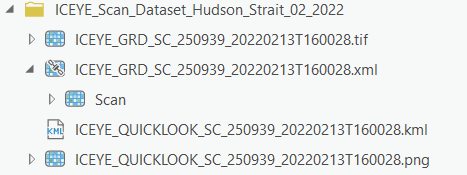
To learn more about ICEYE, visit the ICEYE website.
RADARSAT-2
RADARSAT-2 is an MDA and Canadian Space Agency (CSA) joint SAR mission. It is a C-band SAR satellite in a sun-synchronous orbit (798 kilometers), operating at a center frequency of 5.404 GHz (wavelength of approximately 5.547 centimeters). The satellite collects data in 20 modes with coverage of up to 530 kilometers and resolutions as fine as 1 meter. Various modes of RADARSAT-2 offer single-polarization (HH or VV), dual-polarization (HH+HV or VV+VH), and quad-polarization (HH+VV+HV+VH) options.
| Polarization | Band | Wavelength (cm) |
|---|---|---|
HH | C | 5.5 |
VV | C | 5.5 |
HV | C | 5.5 |
VH | C | 5.5 |
Product types
The RADARSAT-2 SAR Georeferenced Extra (SGX), SAR Georeferenced Fine (SGF), ScanSAR Narrow Beam (SCN), ScanSAR Wide Beam (SCW), ScanSAR Fine (SCF), ScanSAR Sample (SCS), and Single Look Complex (SLC) products are supported.
- SGX, SGF, SCN, SCW, SCF, and SCS—These products are images that have been multilooked and projected to ground range using an Earth ellipsoid model. A ground range image is stored as a real value array. The value in each pixel represents the amplitude of the reflected backscatter signal. Ground range products contain approximately square resolution pixel and square pixel spacing.
- SLC - These products are images in the slant range. An SLC image is stored as a complex value array. The single complex value in each pixel represents the amplitude and phase of the reflected backscatter signal.
The following polarizations are available with RADARSAT-2 products:
- HH—The radar signals are transmitted horizontally and received horizontally.
- VV—The radar signals are transmitted vertically and received vertically.
- HV—The radar signals are transmitted horizontally and received vertically.
- VH—The radar signals are transmitted vertically and received horizontally.
- HH HV—Dual HH+HV polarization.
- VV VH—Dual VV+VH polarization.
- HH VV HV VH—Quad-polarization.
Processing templates
The following processing templates are available:
- Fine—Only Fine mode data will be processed.
- Fine Quad Polarization—Only Fine Quad Polarization mode data will be processed.
- High Incidence—Only High Incidence mode data will be processed.
- Low Incidence—Only Low Incidence mode data will be processed.
- Multi-Look Fine—Only Multi-Look Fine mode data will be processed.
- ScanSAR Narrow—Only ScanSAR Narrow mode data will be processed.
- ScanSAR Wide—Only ScanSAR Wide mode data will be processed.
- SpotlightA —Only SpotlightA mode data will be processed.
- Standard —Only Standard mode data will be processed.
- Standard Quad polarization—Only Standard Quad Polarization mode data will be processed.
- Ultrafine —Only Ultrafine mode data will be processed.
- Wide —Only Wide mode data will be processed.
Raster product support
The raster product is in the RADARSAT-2 product directory, where the product.xml file represents the raster product container.
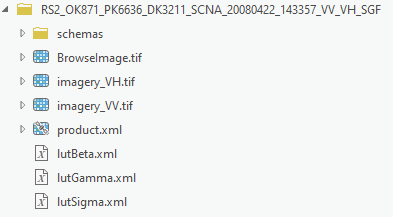
Expanding the .xml file shows the raster products by the available mode and type. Both the raster container and raster product can be loaded to ArcGIS Pro. The available polarizations are represented as bands in the raster product.
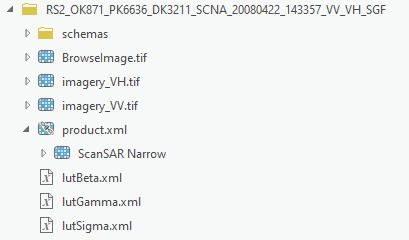
To learn more about RADARSAT-2, visit the MDA website.
RADARSAT Constellation Mission (RCM)
The RADARSAT Constellation Mission (RCM) is the newest generation CSA C-band SAR satellite constellation. It is composed of three identical satellites equally spaced in a low-Earth orbit (586 to 615 kilometers) and operates at a center frequency of 5.404 GHz (wavelength of approximately 5.547 centimeters). The satellites collect data in 12 modes with coverage of up to 500 kilometers and resolutions as fine as 3 meters. Various modes of RCM offer single-polarization (HH or VV), dual-polarization (HH+HV or VV+VH or HH+VV), quad-polarization (HH+VV+HV+VH), and compact polarization (CH+CV) options.
| Polarization | Band | Wavelength (cm) |
|---|---|---|
HH | C | 5.5 |
VV | C | 5.5 |
HV | C | 5.5 |
VH | C | 5.5 |
CH | C | 5.5 |
CV | C | 5.5 |
Product types
The RCM Ground Range Detected (GRD) product (in GeoTIFF or NITF formats) and Single Look Complex (SLC) product are supported.
Processing templates
The following processing templates are available:
- Low Resolution 100m—Only Low Resolution 100m mode data will be processed.
- Medium Resolution 50m—Only Medium Resolution 50m (includes High Incidence and High PRF) mode data will be processed.
- Medium Resolution 30m—Only Medium Resolution 30m mode data will be processed.
- Medium Resolution 16m—Only Medium Resolution 16m mode data will be processed.
- High Resolution 5m—Only High Resolution 5m mode data will be processed.
- Very High Resolution 3m—Only Very High Resolution 3m mode data will be processed.
- Low Noise—Only Low Noise mode data will be processed.
- Ship Detection—Only Ship Detection mode data will be processed.
- Spotlight—Only Spotlight mode data will be processed.
- Quad-polarization—Only Quad-polarization mode data will be processed.
Note that for SLC products, the ScanSAR mode is currently not supported. The following non-ScanSAR modes are supported:
- Spotlight
- Very High Resolution 3m
- High Resolution 5m
- Medium Resolution 16m
- Quad-polarization
The following polarizations are available with RCM products:
- HH—The radar signals are transmitted horizontally and received horizontally.
- VV—The radar signals are transmitted vertically and received vertically.
- HV—The radar signals are transmitted horizontally and received vertically.
- VH—The radar signals are transmitted vertically and received horizontally.
- CH—The radar signals are transmitted circularly and received horizontally.
- CV—The radar signals are transmitted circularly and received vertically.
- HH HV—Dual HH+HV polarization.
- VV VH—Dual VV+VH polarization.
- HH VV—Dual HH+VV polarization.
- CH CV—Dual Compact polarization.
- HH VV HV VH—Quad -polarization.
Each mode of RCM acquires the data in multiple beams defined by different incidence angle ranges. Each beam has unique naming known as a beam mnemonic based on the imaging configuration. The beam of interest can be selected using its mnemonic on the RCM raster type property page for a given processing template and polarization type.
Raster product support
The raster product is in the RCM dataset directory, where the manifest.safe file represents the raster product container.

Expanding the manifest.safe file shows the raster products by mode. Both the raster container and raster products can be loaded to ArcGIS Pro. The available polarizations are represented as bands in the raster product.
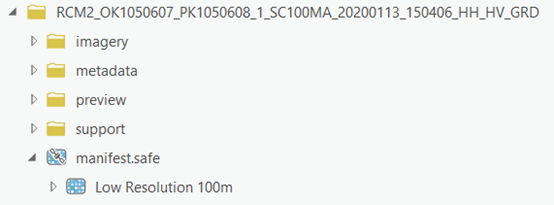
To learn more about the RCM constellation, visit the Canadian Space Agency website.
Sentinel-1
Sentinel-1 is the European Space Agency's (ESA) C-band SAR satellite constellation comprising three polar-orbiting satellites, Sentinel-1A, Sentinel-1B and Sentinel-1C. They operate at a center frequency of 5.405 GHz (wavelength of approximately 5.547 centimeters). The satellites collect data in four modes—Stripmap (SM), Interferometric Wide Swath (IW), Extra-Wide Swath (EW), and Wave (WV)—with swath of up to 400 kilometers and resolution as fine as 5 meters. SM, IW, and EW modes offer single (HH or VV) and dual (HH+HV or VV+VH) polarization options; the WV mode only offers a single (HH or VV) polarization option.
| Polarization | Band | Wavelength (cm) |
|---|---|---|
HH | C | 5.5 |
VV | C | 5.5 |
HV | C | 5.5 |
VH | C | 5.5 |
Product types
The Sentinel-1 Ground Range Detected (GRD) and Single Look Complex (SLC) products are supported.
- GRD—These products are images that have been multilooked and projected to the ground range using an Earth ellipsoid model. A GRD image is stored as a real value array. The value in each pixel represents the amplitude of the reflected backscatter signal. GRD products contain approximately square resolution cells and square pixel spacing.
- SLC—These products are images in the slant range. An SLC image is stored as a complex value array. The single complex value in each pixel represents the amplitude and phase of the reflected backscatter signal.
Processing templates
Currently, the Sentinel-1 raster type only supports the following Level-1 products in IW, SM, and EW modes:
- All Swaths—All modes of data will be added. This is the default template and is used for basic visualization.
- EW—Only EW data will be processed.
- EW1-EW5—Only EW data of subswaths one to five will be processed, respectively.
- IW—Only IW data will be processed.
- IW1—Only IW subswath 1 data will be processed.
- IW2—Only IW subswath 2 data will be processed.
- IW3—Only IW subswath 3 data will be processed.
- S1-S6—Only SM mode data of swaths one to six will be processed, respectively.
The following polarizations are available with Sentinel-1 products:
- HH—The radar signals are transmitted horizontally and received horizontally.
- VV—The radar signals are transmitted vertically and received vertically.
- HV—The radar signals are transmitted horizontally and received vertically.
- VH—The radar signals are transmitted vertically and received horizontally.
- HH HV—Dual HH+HV polarization.
- VV VH—Dual VV+VH polarization.
Raster product support
The raster products are in the .SAFE directory, where the manifest.safe file represents the raster product container. Expanding the manifest.safe file shows the raster products by mode. Both the raster container and the raster products can be loaded to ArcGIS Pro. The available polarizations are represented as bands in the raster product.
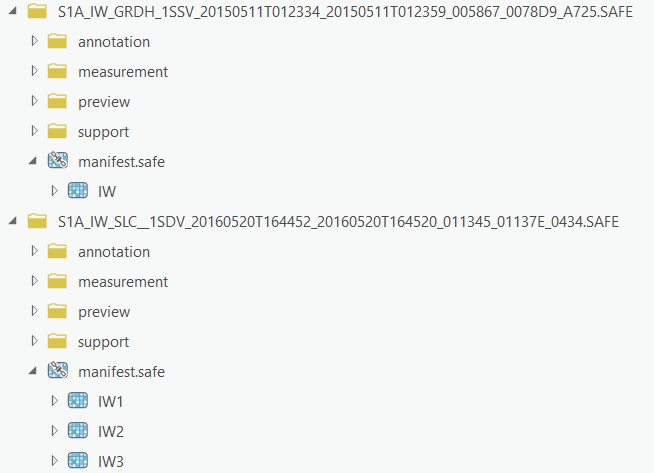
To learn more about Sentinel-1, visit the European Space Agency website.